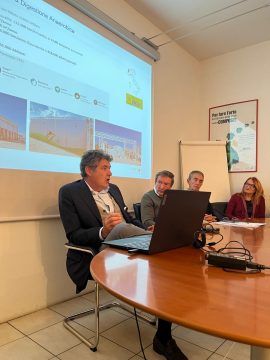An update meeting was held Wednesday, Oct. 9, at Acsr Spa in Borgo San Dalmazzo on the technological upgrading of the current composting plant with the inclusion of a new anaerobic digestion section to produce biomethane, a project authorized last Aug. 5 by the Services Conference.
Present at the meeting were the mayors of the 54 member municipalities of the Azienda cuneese smaltimento rifiuti (Cuneo Waste Disposal Company), the directors of the Consorzio Ecologico Cuneese (Cuneo Ecological Consortium), the recipient of the PNRR grant, as well as our President Pier Cella Mazzariol, who was invited as the company entrusted with the work. During the meeting it was also decided to plan a visit to the latest plant built by Entsorga in Siena in November.
“Since we were born, the same year as the Ronchi Decree, we have been studying and patenting technologies for waste treatment, including those for transforming wet waste into green matter and energy,” commented Cella Mazzariol ”In Entsorga, and in Italy in general, on this front we have achieved unique milestones in terms of efficiency, safety and innovation, which have been exported all over the world. We are an example in the environmental field, because for 30 years we have been thinking and finding solutions to problems that were immediately more urgent for us than for others, being a country with a high population density and little space for landfills. We should be proud to represent excellence, to have at our disposal the best technologies available on the market and to use them to bring to life a strategic project for Borgo, and for the entire country.”
Thanks to the expansion, the Borgo plant will process 35 thousand tons per year of wet waste from separate collection and turn it into 3.6 million metric cubic meters of biomethane. We are talking about 10 thousand tons per year more than the current capacity, which is absolutely in line with the projected needs of the area. Those who think it is oversized are underestimating the amount of waste that each of us manages to produce every day: almost one and a half kilograms, of which wet waste is the predominant part. An important amount to dispose of, but also a real green energy resource.
“To give you an idea of how much this expansion will mean for the area,” continued Cella Mazzariol, ”we bring you the example of Santhià, in the Vercelli area, where the same technologies that will be adopted in Borgo have been used for 14 years, in a plant as large as the one that will result at the end of the work. Here they process about 1,000 tons per month of wet waste, obtained from the waste produced by about 25,000 inhabitants. Well, from such a plant every day we get enough biomethane to power more than 40,000 washing machines, 66,000 hair dryers, 20,000 refrigerators or 50,000 dishwashers. We can say that each inhabitant can dry his or her hair 3 times a day or do a double load of the dishwasher or washing machine using only clean, green energy obtained from his or her organic waste. This is not future, it is already present, and for us it is the only possible and sustainable one.”


